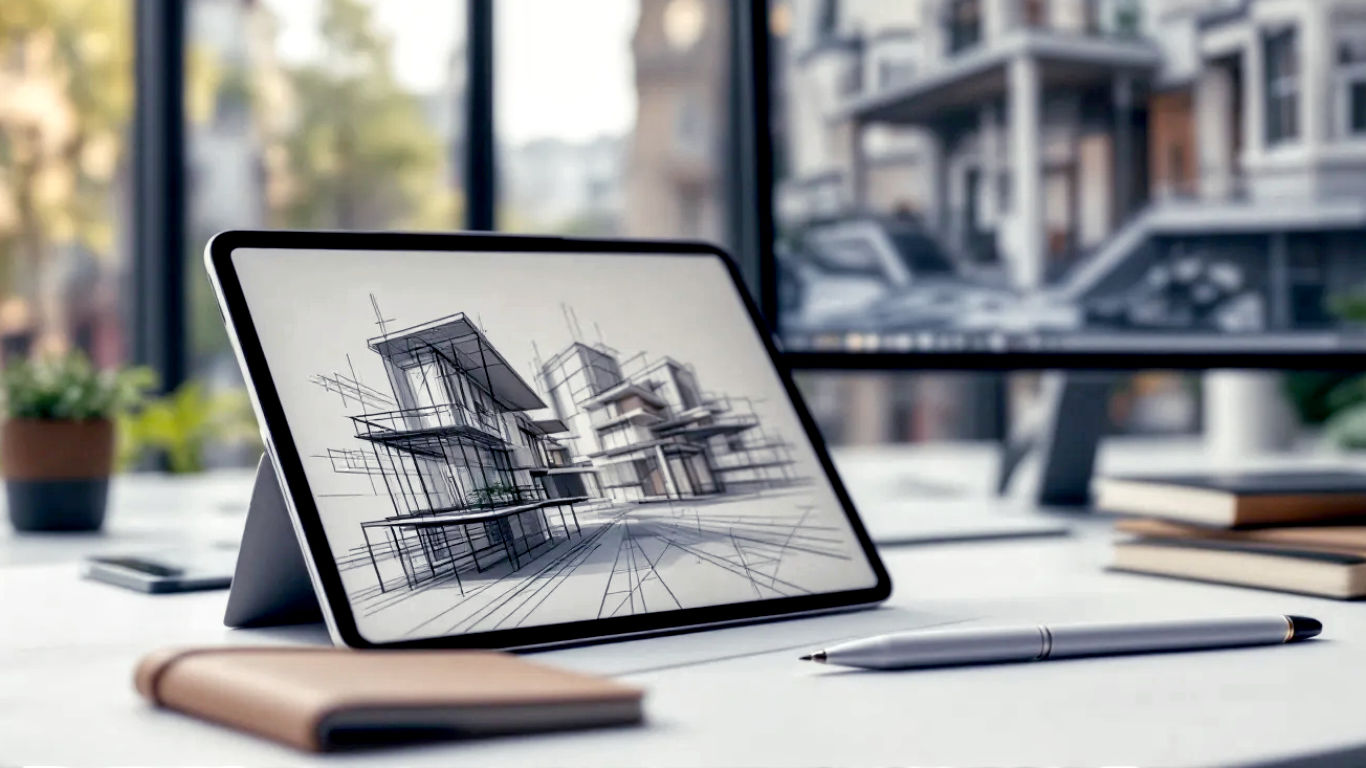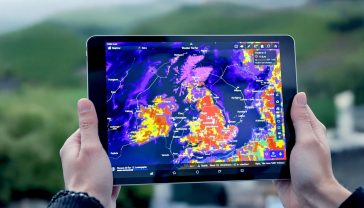10 Best Apps for Architects: Streamline Your Design Process in 2026
From Revit to Procreate, explore the ultimate digital toolkit for modern architects. Streamline your design process with the best apps for every stage, from concept to construction.

This post may contain affiliate links. If you make a purchase through these links, we may earn a commission at no additional cost to you.
Ever wondered how magnificent buildings like The Shard in London or the V&A Dundee leap from a flicker of imagination into towering reality? In the past, it was all down to pencils, paper, and painstaking manual drawings. An architect’s studio would have been a sea of blueprints and drafting tables. Today, things are a bit different. While the creative spark is still human, the tools have had a serious upgrade.
The modern architect’s toolkit isn’t just a fancy pencil case; it’s a powerful collection of digital apps that can run on a tablet, a phone, or a high-spec computer. These aren’t just for drawing lines. They help architects dream up ideas, create stunning 3D models, manage complex projects, and even walk clients through a virtual version of a building before a single brick is laid. Think of them as a digital Swiss Army knife for building design.
From the initial scribble on a digital napkin to the final construction plan, apps have completely changed the game. They make it easier to collaborate with engineers and builders, spot potential problems early on, and present ideas in a way that gets everyone excited. They’ve made the whole process faster, smarter, and more creative.
So, whether you’re a student just starting your journey at the Bartlett School of Architecture, a seasoned professional running a small practice in Manchester, or just someone fascinated by how buildings are made, you’re in the right place. We’re about to explore the ten best apps that are shaping the future of architecture in the UK and beyond. Let’s dive in and discover the digital tools that are helping to build tomorrow’s world.
The Foundation: What Makes a Great Architecture App?
Before we jump into our top ten list, it’s worth thinking about what actually makes an app useful for an architect. It’s not just about having lots of flashy features. The best apps are the ones that fit seamlessly into the complex, multi-stage process of designing a building. They need to be more than just a digital drawing board; they need to be a reliable partner in creation.
At its heart, architecture is about solving problems. How do you create a space that’s beautiful but also functional? How do you make sure it’s safe, sustainable, and within budget? The journey from the first client meeting to the finished building is long and winding, involving sketches, detailed plans, 3D models, and endless coordination.
A great app helps at every step of this journey. Here’s a breakdown of the key stages and what architects look for in their digital tools:
1. Conceptual Design & Sketching
This is the very beginning, where ideas are born. It’s all about brainstorming and getting rough concepts down quickly.
- What architects need: An app that feels as natural and intuitive as sketching on paper. It should be fast, flexible, and let creativity flow without getting bogged down in complicated menus. Think digital pencil and paper, but with the ability to easily undo, layer ideas, and experiment with colours and textures.
2. Detailed Design & 3D Modelling
Once the initial idea is there, it’s time to give it form and detail. This is where architects create precise 2D drawings (floor plans, elevations) and build detailed 3D models.
- What architects need: Power and precision. These apps must handle complex geometry and large files without crashing. They need tools for accurate drafting, modelling, and creating photorealistic visuals (renders) that show what the final building will look like. This is where Building Information Modelling (BIM) often comes in—a smart 3D model-based process that gives architects, engineers, and construction professionals the insight and tools to more efficiently plan, design, construct, and manage buildings and infrastructure.
3. Collaboration & Project Management
Designing a building is a team sport. Architects have to work closely with clients, engineers, surveyors, and builders.
- What architects need: Tools that make teamwork easy. This means cloud-based file sharing, the ability for multiple people to comment on or edit drawings (known as ‘redlining’), and features for tracking tasks and deadlines. Everything needs to be in one place, accessible from the office or a muddy construction site.
4. On-Site Work & Presentation
Architects spend a lot of time out of the office, visiting sites to check progress or meeting clients to present their designs.
- What architects need: Mobility is key. Apps must work flawlessly on tablets and smartphones. They should be able to pull up any drawing or 3D model instantly, take measurements with the device’s camera, and present ideas in a clear, engaging way. Augmented Reality (AR) is a huge bonus here, as it allows architects to overlay their 3D models onto the real world, giving clients a magical glimpse of the future.
So, a top-tier architecture app blends intuitive design for creative moments with powerful performance for technical tasks, all while supporting seamless collaboration and on-the-go mobility. The apps on our list excel in one or more of these areas, making them indispensable tools for the modern architect.
The Top 10 Apps for Architects in 2026
Now for the main event. We’ve sifted through the crowded marketplace of design software to bring you the ten apps that truly stand out. These tools are trusted by professionals across the UK, from small, independent practices to large, world-renowned firms. We’ll look at what makes each one special, who it’s best for, and how it fits into the architectural workflow.
1. Autodesk Revit: The Industry Standard for BIM
If there’s one name that dominates the world of architectural software, it’s Autodesk. And Revit is its flagship product for Building Information Modelling (BIM). For many larger architecture firms in the UK, using Revit isn’t just a choice; it’s a requirement for government and major commercial projects.
What it is: Revit is not just a 3D modelling tool. It’s a complete system for creating intelligent models that contain vast amounts of information. When you draw a wall in Revit, it’s not just a set of lines. The model knows it’s a wall, what it’s made of, how much it costs, and how it connects to the floor and roof. Change the wall in one view (like a floor plan), and it automatically updates everywhere else—in 3D views, sections, and schedules. This is the power of BIM.
Why architects love it:
- Integrated Design: It connects all aspects of a building project in one model, from the initial design to the construction phase and even facility management after it’s built. This reduces errors and improves coordination between architects, structural engineers, and MEP (mechanical, electrical, and plumbing) engineers.
- Powerful Collaboration: With its work-sharing features, entire teams can work on the same central model at the same time. This is crucial for large, complex projects like hospitals or airports.
- Automatic Updates: The automatic coordination of changes is a massive time-saver and dramatically reduces the chance of human error. No more manually updating dozens of drawings because a window was moved.
Best for: Professional architects, large teams, and anyone working on complex projects where BIM is mandated. It’s the powerhouse of the industry.
Things to consider: Revit has a very steep learning curve. It’s a complex piece of software that requires significant training to master. It’s also expensive and needs a powerful computer to run smoothly.
2. SketchUp: The 3D Sketchbook for Everyone
If Revit is the heavyweight champion, SketchUp is the nimble, friendly contender that’s surprisingly powerful. It started life as a tool that was famously easy to use, and it has maintained that reputation while adding professional-grade features over the years. Many architects use it for the early stages of design because it’s so quick and intuitive.
What it is: SketchUp is a 3D modelling application that feels more like drawing with your hands than operating complex software. Its “Push/Pull” tool, which allows you to easily turn any flat shape into a 3D form, is legendary for its simplicity. You can knock up a quick massing model of a building in minutes, making it perfect for exploring ideas.
Why architects love it:
- Ease of Use: You can learn the basics of SketchUp in an afternoon. This makes it incredibly accessible for students, small practices, or anyone who wants to visualise an idea quickly without getting bogged down in technical details.
- Vast Component Library: Its 3D Warehouse is a massive online library of free 3D models. Need a specific chair, window, or even a tree for your design? Chances are someone has already modelled it and shared it.
- Great for Conceptual Design: It’s the perfect tool for bridging the gap between a 2D sketch and a full BIM model. It allows for fluid, creative exploration of form and space.
Best for: Conceptual design, massing studies, small to medium-sized projects, and architects who value speed and intuitive design. It’s also popular with interior designers and landscape architects.
Things to consider: While the pro version is very capable, its core strength is in modelling, not in producing the detailed construction drawings and data management that you get with a tool like Revit. Many firms use SketchUp for initial design and then move the project into a BIM application for detailed development.
3. AutoCAD: The Original Digital Drafting Table
Before BIM and 3D modelling became the norm, there was AutoCAD. For decades, this was the software for architects. It revolutionised the industry by replacing the physical drawing board with a digital one. While many have moved on to 3D-centric workflows, AutoCAD is still a cornerstone of the profession, especially for 2D drafting.
What it is: AutoCAD is a computer-aided design (CAD) program that excels at creating precise 2D drawings—floor plans, sections, elevations, and details. It’s the digital equivalent of technical drawing, offering unparalleled control and accuracy. Its latest versions have also incorporated powerful 3D modelling features, but its heart and soul remain in 2D.
Why architects love it:
- Unmatched Precision: For pure 2D drafting, AutoCAD is still the king. Its command-line interface and powerful toolset allow for incredible speed and accuracy once mastered.
- Industry Standard Format: The .DWG file format used by AutoCAD is universal. Virtually every architect, engineer, and contractor in the world can open and work with a DWG file. This makes it a reliable format for sharing information.
- Flexibility: It’s used for everything from architectural drawings to product design and manufacturing. This versatility means it’s a familiar tool for many different disciplines involved in a building project.
Best for: 2D technical drawing, detailing, and producing construction documents. It’s an essential skill for any architect, even if they primarily work in a 3D BIM environment.
Things to consider: It’s not a BIM application. A line in AutoCAD is just a line; it doesn’t have the intelligent data of a Revit element. The workflow is less integrated, and changes need to be manually coordinated across different drawings.
4. Rhino 3D: The Master of Complex Shapes
What if your design isn’t all straight lines and simple boxes? What if you’re Zaha Hadid Architects, designing fluid, futuristic buildings with incredible curving forms? For that, you need a tool that can handle complex geometry with ease. And for many architects, that tool is Rhino 3D.
What it is: Rhino is a powerful 3D modelling software that uses NURBS (Non-Uniform Rational B-Splines) geometry. That sounds complicated, but it basically means it’s incredibly good at creating smooth, complex, and highly accurate curves and surfaces. It’s the go-to tool for architects and designers who are pushing the boundaries of form.
Why architects love it:
- Freedom of Form: It allows for the creation of virtually any shape imaginable, from the flowing roof of a cultural centre to the intricate pattern on a building’s facade.
- Computational Design: Rhino is famous for its integration with Grasshopper, a visual programming plugin. Grasshopper allows architects to create designs using algorithms. This is known as parametric or computational design, and it’s behind many of the most innovative buildings of the 21st century. You can design a complex facade, for example, and then easily change parameters (like the size of the openings or the angle of the sun) to see the entire design update instantly.
- Versatility: It’s not just for architecture. Rhino is used in industrial design, jewellery design, and naval architecture, which speaks to its power and flexibility.
Best for: Architects and designers focused on complex, non-standard geometry, computational design, and digital fabrication.
Things to consider: Like Revit, Rhino has a steep learning curve, especially when you start using Grasshopper. It’s a specialist tool for the modelling part of the design process and needs to be used alongside other software for producing construction documents.
5. Procreate: The Digital Sketchpad Perfected
Every great building starts with a simple sketch. For a long time, architects were loyal to their Moleskine notebooks and Lamy pens. But the iPad, combined with the Apple Pencil and an app like Procreate, has created a digital sketching experience that is winning over even the most traditional designers.
What it is: Procreate is a drawing and painting app for iPad that is beloved by artists and designers for its incredible performance and intuitive interface. It’s not specifically an architecture app, but its tools are perfectly suited to the early stages of the design process.
Why architects love it:
- The Feel of Drawing: With the Apple Pencil, sketching in Procreate feels remarkably close to drawing on paper. The response is instant, and the pressure and tilt sensitivity allow for expressive lines. You can choose from hundreds of brushes that mimic everything from a soft 4B pencil to a technical ink pen.
- The Power of Digital: It combines the joy of drawing with the benefits of digital tools. You can work in layers, easily undo mistakes, quickly test different colour schemes, and import a photo of a site to sketch over the top.
- Portability: An iPad with Procreate is an entire art studio in your bag. You can sketch on the train, during a client meeting, or on-site.
Best for: Conceptual sketching, brainstorming, and creating beautiful, artistic illustrations of architectural ideas. It’s the perfect digital replacement for a sketchbook.
Things to consider: It’s a drawing app, not a CAD or modelling program. Your beautiful sketch in Procreate is just a collection of pixels; it has no scale or 3D information. The ideas developed here will need to be redrawn in a program like AutoCAD or Revit.
6. Shapr3D: 3D Modelling on the Go
What if you could combine the intuitive sketching of an iPad app with the power of a professional 3D CAD program? That’s the promise of Shapr3D. It runs on iPad, Mac, and Windows and is designed to make 3D modelling as easy and tactile as possible, especially when used with an Apple Pencil.
What it is: Shapr3D is a user-friendly but powerful 3D modelling app. It’s a direct modeller, which means you create and manipulate shapes directly on the screen. It’s built on the same geometric modelling kernel used by many desktop CAD programs, so it creates precise, solid models that can be exported for use in other software or even for 3D printing.
Why architects love it:
- Intuitive Workflow: Using an Apple Pencil to draw a shape and then pull it into 3D is a fast and satisfying way to work. It’s a much more hands-on experience than using a mouse and keyboard.
- Professional Power: Don’t let its ease of use fool you. Shapr3D is a serious CAD tool capable of creating complex and accurate models. It supports precise measurements and can export to formats compatible with Rhino, AutoCAD, and others.
- Mobility: It empowers architects to do real 3D design work anywhere. You can sit with a client and model changes in real-time or work through a design problem while visiting a site.
Best for: Architects who love working on an iPad and want a tool for creating accurate 3D models quickly and intuitively. It’s great for conceptual design and product design.
Things to consider: It’s focused on modelling. For creating full sets of 2D construction drawings, you will likely need to export your model to a different application.
7. Morpholio Trace: The Architect’s Digital Tracing Paper
Tracing paper has been a fundamental tool for architects for centuries. It allows them to sketch over existing drawings, layering ideas and refining designs. Morpholio Trace brilliantly reimagines this process for the iPad.
What it is: Morpholio Trace is a sketching app designed by architects, for architects. Its standout feature is its intelligent, layer-based workflow that mimics the use of tracing paper. You can import a base drawing, a map, or a photo, and then add layers on top to sketch out your ideas.
Why architects love it:
- AR Sketching: It has a fantastic Augmented Reality feature that lets you project your sketch onto the real world. You can sketch a new facade directly onto an existing building or see how a new piece of furniture would look in a room, all through your iPad’s camera.
- Intelligent Tools: The app includes a range of tools designed specifically for architects, such as smart rulers, stencils for furniture and trees, and perspective grids that make 3D sketching a breeze.
- Scale and Precision: Unlike a simple drawing app, Trace understands scale. You can set a scale for your drawing, and your measurements will be accurate. This makes it a much more useful tool for actual design work.
Best for: Early-stage design, site analysis, and marking up drawings and photos. It’s a powerful and versatile tool for any architect who uses an iPad.
Things to consider: It’s an Apple-ecosystem app, so it’s not available for Android or Windows users.
8. Bluebeam Revu: The Ultimate PDF Markup Tool
A huge part of an architect’s job involves reviewing and commenting on drawings. In the digital age, this means dealing with hundreds of PDF files. Bluebeam Revu has become the industry-standard tool for managing this process. It’s often described as “Adobe Acrobat on steroids, specifically for the construction industry.”
What it is: Bluebeam Revu is a powerful software for creating, editing, marking up, and collaborating on PDF files. It allows architects, engineers, and contractors to add comments, measurements, and symbols to drawings with precision and ease.
Why architects love it:
- Industry-Specific Tools: Revu is packed with features designed for the Architecture, Engineering, and Construction (AEC) industry. This includes taking accurate measurements from drawings, comparing different versions of a document to see what’s changed, and creating customised tool sets with standard architectural symbols.
- Real-Time Collaboration: Its Studio feature allows teams to view and mark up the same set of documents together in real-time, no matter where they are. It’s like having a project meeting around a drawing table, but digitally.
- Document Management: It’s a brilliant tool for organising and managing the vast number of documents a project generates, from initial sketches to final construction drawings.
Best for: Reviewing and marking up drawings, collaborating with the wider project team, and managing project documents. It is an absolutely essential tool for day-to-day workflow.
Things to consider: It’s a very deep program with a huge number of features, so it can take some time to learn how to use it to its full potential.
9. Asana: Keeping Ambitious Projects on Track
Designing a building involves juggling hundreds of tasks, deadlines, and responsibilities. A simple to-do list just won’t cut it. That’s where a dedicated project management tool like Asana comes in. While not specific to architecture, its flexibility and power make it a perfect fit for managing design projects.
What it is: Asana is a web and mobile application designed to help teams organise, track, and manage their work. You can create projects, assign tasks to team members, set deadlines, and see at a glance who is doing what and when.
Why architects love it:
- Visual Timelines: Its timeline feature (a Gantt chart) is perfect for mapping out the entire project schedule, from the initial design phase through to construction milestones. You can easily see how different tasks depend on each other.
- Centralised Communication: It keeps all communication about a specific task in one place, cutting down on endless email chains. You can attach files (like drawings or photos) directly to tasks.
- Flexibility: It can be adapted to any workflow. An architecture practice can create templates for different project types, ensuring a consistent process every time.
Best for: Project management, team coordination, and keeping track of all the moving parts of a design and construction project.
Things to consider: To get the most out of it, the whole team needs to commit to using it consistently. Some of its more advanced features are only available on the paid plans. Trello and Monday.com are popular alternatives with similar features.
10. Sun Seeker: Harnessing the Power of the Sun
Good architecture responds to its environment, and one of the most important environmental factors is the sun. Understanding how sunlight will move across a site and enter a building throughout the day and year is crucial for designing comfortable, energy-efficient spaces. Sun Seeker is a wonderfully simple but powerful app that makes this easy.
What it is: Sun Seeker is an augmented reality app that shows you the path of the sun. You can hold up your phone or tablet and see the sun’s trajectory overlaid on your camera view for any time of day or year. It shows you exactly where the sun will be and where shadows will fall.
Why architects love it:
- On-Site Analysis: It’s invaluable during a site visit. An architect can stand on a plot of land and instantly understand which areas will get morning sun, where to place windows to capture winter light, and where to position shading to block the harsh summer sun.
- Design Aid: Back in the office, it can be used to check how sunlight will interact with a 3D model, helping to design everything from the angle of the roof to the size of the window overhangs.
- Simple and Visual: It presents complex solar data in a way that is immediately understandable. You can even show it to a client to explain why a certain room is positioned where it is.
Best for: Site analysis, sustainable design, and understanding the impact of natural light on a project. It’s a must-have app for any environmentally-conscious architect.
Things to consider: It’s a specialised tool for one specific, albeit very important, task.
The Future is Integrated: How These Apps Work Together
It’s rare that a single app will be used for an entire project. The real magic happens when these tools are used together, creating a seamless workflow that takes an idea from a simple sketch to a fully realised building.
A typical digital workflow for a modern architect in the UK might look something like this:
- Inspiration on the Go: The process might start on an iPad during a client meeting. The architect uses Procreate or Morpholio Trace to quickly sketch out some initial ideas, capturing the client’s vision in a fluid, artistic way.
- Exploring Form: Back at the studio, these initial sketches are developed into 3D forms using SketchUp or Shapr3D. This allows for quick exploration of the building’s overall shape and scale. If the design involves complex curves, the architect might use Rhino 3D.
- Developing the Detail: Once the concept is approved, the model is imported into Revit or AutoCAD. This is where the hard work of detailed design begins. The architect creates precise construction drawings, adds technical information, and coordinates with structural and MEP engineers within the BIM model.
- Review and Collaborate: As drawings are produced, they are exported as PDFs and shared with the project team using Bluebeam Revu. Everyone can add their comments and markups in one central place. The entire project is managed in Asana, ensuring everyone knows their tasks and deadlines.
- Checking on Site: During a site visit, the architect uses the Sun Seeker app to verify solar orientation and uses the Revit mobile app to pull up the 3D model to clarify a detail with the construction team.
This integrated process, where each app plays to its strengths, is what allows architects today to design and deliver buildings of incredible complexity and beauty. The digital toolkit has become as essential as the creative mind that wields it, helping to design a better, more thoughtfully constructed world for us all. The next time you walk past an impressive new building, you can be sure that some of this amazing software played a crucial part in its creation.
Further Reading
To continue your exploration of architectural technology and design, here are some highly respected resources:
- ArchDaily: A leading source for architecture news, projects, and articles on technology.
- Dezeen: An influential online architecture and design magazine, often featuring innovative uses of technology.
- RIBA Journal (RIBAJ): The official magazine of the Royal Institute of British Architects, offering insights into the profession in the UK.
- Architects’ Journal (AJ): A long-standing publication covering the UK architecture scene, including practice matters and technology reviews.






